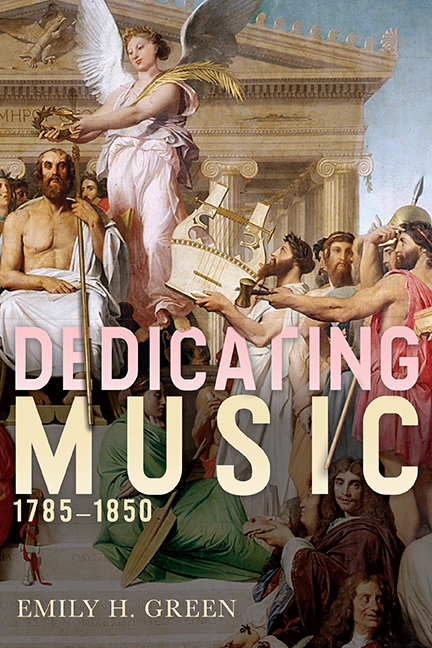Epilogue: Dedications and Romanticism
Published online by Cambridge University Press: 03 September 2019
Summary
The apparent tensions in this study—that dedications can be simultaneously relics of an older economy and markers of the new, models for both antiquated and recent conceptions of the composer's self, and claims of multiple and solitary authorship—cut to the heart of Romanticism itself. Ralph Waldo Emerson addresses this tension in his odd but relevant essay “Gifts” (1844), excerpted at the opening of chapter 3. Here, he waffles between trying to resolve a banal kind of modern gift-giving conundrum and the typical transcendentalist selfreliance he preached in other essays. “I am puzzled what to give, until the opportunity is gone; Flowers and fruits are always fit presents,” he opines, not two paragraphs before claiming that “it is not the office of a man to receive gifts. How dare you give them? We wish to be self-sustained. We do not quite forgive a giver.”1 Between those sentiments lies an argument about the connection between the self and the commodified gift: for Emerson, giving is a performance of the self that needs to be authentic but that always already cannot be authentic because of its participation in a reciprocal—and, by implication, market—economy. He continues: “For the rest, I like to see that we cannot be bought and sold. The best of hospitality and of generosity is also not in the will, but in fate.” Emerson captures the essence of the complex role the Romantic ethos imposed on dedications toward 1850: to present their participants as authentic and thereby ensure a work's financial success, they must maintain an artist's social relations without upsetting the image of her independence and commercial disengagement.
We see that split presentation in the host of spurious documents that circulated posthumously about Mozart. A famous forged Mozart letter, published in the Allgemeine musikalische Zeitung in 1815 and translated in the Harmonicon in 1825, provides a portrait of an artist who has a careful and detailed music correspondence with a higher-status addressee and yet sees the ideal composition process as completely solitary. First, “Mozart” greets an anonymous, fictional baron with polite criticism of a set of compositions his addressee had apparently given him to peruse. “Herewith I return to you, my good Baron, your scores,” he begins before reporting that the symphony “is much too crowded” but that the song “has a beautiful cantabile” and the minuet “is pleasing enough” despite a vapid coda.
- Type
- Chapter
- Information
- Dedicating Music, 1785–1850 , pp. 174 - 180Publisher: Boydell & BrewerPrint publication year: 2019



